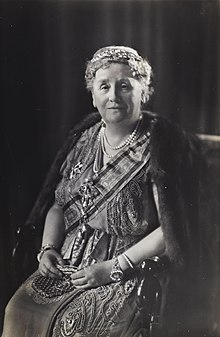
Back Wilhelmina van Nederland Afrikaans فيلهلمينا ملكة هولندا Arabic فيلهلمينا ملكة هولندا ARZ Vilhelmina Azerbaijani ویلهلمینای (هولند) AZB Вільгельміна (каралева Нідэрландаў) Byelorussian Вилхелмина Нидерландска Bulgarian Wilhelmina an Izelvroioù Breton Vilma, kraljica Nizozemske BS Guillemina I dels Països Baixos Catalan
| Wilhelmina | |||||
|---|---|---|---|---|---|
 Formal portrait, c. 1948 | |||||
| Queen of the Netherlands | |||||
| Reign | 23 November 1890 – 4 September 1948 | ||||
| Inauguration | 6 September 1898 | ||||
| Predecessor | William III | ||||
| Successor | Juliana | ||||
| Regents | Queen Emma (1890–1898) Princess Juliana (1947–1948) | ||||
| Born | Princess Pauline of Orange-Nassau 31 August 1880 Noordeinde Palace, The Hague, Netherlands | ||||
| Died | 28 November 1962 (aged 82) Het Loo Palace, Apeldoorn, Netherlands | ||||
| Burial | 8 December 1962 Nieuwe Kerk, Delft, Netherlands | ||||
| Spouse | |||||
| Issue | Juliana of the Netherlands | ||||
| |||||
| House | Orange-Nassau | ||||
| Father | William III of the Netherlands | ||||
| Mother | Emma of Waldeck and Pyrmont | ||||
| Religion | Dutch Reformed Church | ||||
| Signature | |||||
Wilhelmina (Dutch pronunciation: [ʋɪlɦɛlˈminaː] ⓘ; Wilhelmina Helena Pauline Maria; 31 August 1880 – 28 November 1962) was Queen of the Netherlands from 1890 until her abdication in 1948. She reigned for nearly 58 years, making her the longest-reigning monarch in Dutch history, as well as the longest-reigning female monarch outside the United Kingdom. Her reign saw World War I, the Dutch economic crisis of 1933 and World War II.
The only surviving child of King William III of the Netherlands and Emma of Waldeck and Pyrmont, Wilhelmina ascended the throne at the age of 10 after her father's death in 1890, under her mother's regency. After taking charge of government, Wilhelmina became generally popular for maintaining Dutch neutrality during the First World War and solving many of her country's industrial problems. By that time, her business ventures had made her the world's first female billionaire as measured by U.S. dollars.[1]
Following the German invasion of the Netherlands in 1940, Wilhelmina fled to Britain and took charge of the Dutch government-in-exile. She frequently spoke to the nation over radio and came to be regarded as a symbol of the Dutch resistance.[1] By 1948, she had returned to the liberated Netherlands and was the only survivor of the 17 European monarchs who were sitting on their thrones at the time of her inauguration.[2] Increasingly beset by poor health, Wilhelmina abdicated in favour of her daughter Juliana in September 1948 and retired to Het Loo Palace, where she died in 1962.
Largely due to her status as a symbol of the Resistance, she remains reasonably popular in the Netherlands, even among the Dutch Republican movement.[3]
- ^ a b "Wilhelmina of Netherlands Dies" (UPI), The New York Times, 28 November 1962. pp. A1–A39.
- ^ "Queen Wilhelmina". Life. Vol. 25, no. 7. 16 August 1948. p. 83. ISSN 0024-3019.
- ^ Fitzwilliams, Richard (30 April 2013). "What Dutch 'Bicycling Royals' Can Teach World's Royals". Cable News Network (CNN).